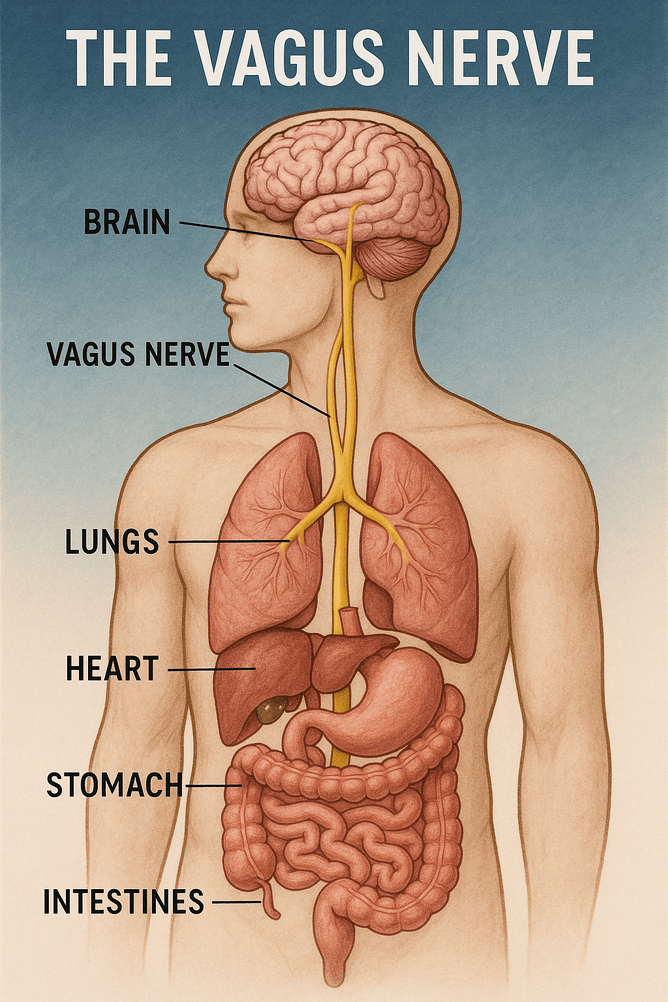Understanding the Power of the Vagus Nerve in Holistic Healing
In the fast-paced world we live in, stress and overwhelm can feel like constants. But what if the key to finding calm, improving digestion, boosting mood, and even reducing chronic inflammation was hidden in a single nerve running from your brain to your gut? Let us introduce you to the Vagus Nerve—a vital part of the body's healing system and a powerful ally in holistic wellbeing.
What is the Vagus Nerve?
The Vagus Nerve (pronounced vay-gus) is the longest cranial nerve in the body. It starts in the brainstem and travels down through the face, heart, lungs, and digestive tract. It plays a central role in the parasympathetic nervous system—your body's rest, digest, and repair mode.
Think of it as the brake pedal to your stress response. When the vagus nerve is functioning well, it helps regulate heart rate, breathing, digestion, and even your emotional state.
Why Is It So Important?
Your vagus nerve is like a communication highway between your brain and your body. It’s responsible for:
Slowing the heart rate
Stimulating digestion
Reducing inflammation
Regulating mood and emotional wellbeing
Supporting immune function
Managing your stress response
When this nerve is underactive—often due to trauma, chronic stress, illness, or inflammation—you might feel anxious, tired, bloated, or emotionally flat. A well-functioning vagus nerve helps the body recover and reset.
Symptoms of Poor Vagal Tone:
Shallow breathing or tight chest
Poor digestion, bloating, or nausea
Depression or anxiety
Feeling constantly 'on edge'
Low immunity
Difficulty sleeping
Fatigue or burnout
How to Stimulate the Vagus Nerve Naturally
Supporting vagus nerve function is one of the simplest and most impactful ways to restore balance in the body. Here are some techniques you can use:
1. Breathwork
Slow, deep belly breathing—especially with a longer exhale—activates the parasympathetic system. Try inhaling for 4 seconds, holding for 4, and exhaling for 6–8.
2. Cold Exposure
A splash of cold water on the face or a cold shower can trigger a vagal response and bring your body back into balance.
3. Humming, Singing, or Chanting
The vagus nerve is connected to the vocal cords. Gentle humming, singing, or even chanting can stimulate it directly and bring on feelings of calm.
4. Herbal Support
Calming herbs like lemon balm, lavender, chamomile, and ashwagandha can support the nervous system and vagus nerve function.
5. Massage and Bodywork
Gentle touch therapies such as Mirimiri, craniosacral therapy, or abdominal massage can all help stimulate the vagus nerve, especially when paired with breath awareness.
6. Connection and Safety
Safe, meaningful relationships stimulate the vagus nerve. Eye contact, compassion, and a sense of belonging are natural regulators of the nervous system.
Final Thoughts
At Te Ara Hou Wellbeing, we often begin with the nervous system—because when your body feels safe, it can begin to heal. Supporting the vagus nerve is a foundational step for many of our clients, especially those navigating trauma, chronic stress, or emotional burnout.
Whether you’re experiencing physical symptoms or emotional disconnection, know that there are simple, natural ways to reconnect your mind and body—and it often starts with the vagus nerve.
Interested in learning more or beginning your own healing journey? Reach out to book a session, or explore our programs that help bring balance back to your body and mind.


